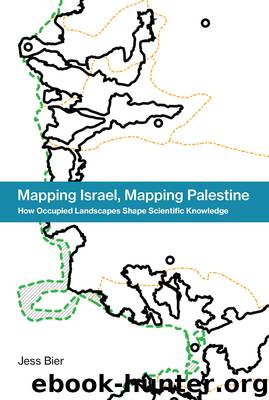Mapping Israel, Mapping Palestine by Jess Bier

Author:Jess Bier
Language: eng
Format: epub
Tags: geography; cartography; maps; political geography; borders; politics; STS; information science; political science
Publisher: The MIT Press
Published: 2017-05-30T00:00:00+00:00
Immobile Elites: NGOs on the Move
Since 2008, the raids on institutions (e.g., Matar 2012; Nusseibeh 2012) and attacks on data infrastructure (Tawil-Souri 2011b) have continued. The incursion into mapping and census offices thus also forms part of the destruction of Palestinian knowledge and forms of information far more broadly (Aouragh 2015). Presently the stasis and physical integrity of Palestinian knowledge centers are far from assured. This adds texture to existing debates over the relevance of local scientific practices to broader institutional systems (e.g., Lynch 1993, 112), because the institutional practices are localized as well—in this case, in relation to their repeated destruction. Their stasis is not only shaped by direct assaults, however, but also is affected by the very constitution of knowledge landscapes.
In the absence of a fully recognized state of Palestine, political movements provide the primary support for memorials and national commemoration (Khalili 2007). Additionally, businesses (Bouillon 2004) and NGOs perform professional functions that otherwise might be under the purview of a national government. These include the production and preservation of empirical maps (Ibrahim 2011; Jensen, Abed, and Tellefsen 1997). Yet NGOs are often highly transitory, subject to outside control, and their future depends on fickle international aid cycles and grants (Hanafi and Tabar 2003).
This creates difficulties when conducting research, as Zureik, David Lyon, and Yasmeen Abu-Laban (2011, 1) point out in their recent study on information society in Palestine: “It is an understatement to admit that working in an emergent country like Palestine is not an easy task, particularly when the data … are hard to come by.”21 At the inception of the PPIB, the effects of Israeli military control combined with the prevalence of NGOs, at least partly as a result of the occupation, to ensure that the PA had no local map archive at its disposal.22 Referring to the “almost total lack of basic data,” in no small part because such data were “considered to be military secrets by the Israelis,” one consultant simply states, “There were no maps” (Tesli 2008, 23).23
This enforced transitory character of Palestinian institutions interacts in complex ways with the stasis and mobility of the cartographers who have built and rebuilt those institutions. In addition to restricting the scale of their maps through the use of British colonial data, it shapes their ability to conduct surveys or otherwise collect data on the ground. This has the effect of restricting the extent of the new data that they can produce, with the end result that on PA maps, some areas are depicted in much greater detail than others. Attention to the multiple scales of PA mapmaking practices allows for a more detailed understanding of the specific ways that particular data sets are affected.
While discussions of Palestinian mobility tend to focus on local or regional movement (e.g., B’Tselem 2004), the mobility and stasis of PA cartographers and institutions must be viewed across geographic scales, including at international ones. The fact that many NGOs and PA ministries receive international aid with the precise aim of
Download
This site does not store any files on its server. We only index and link to content provided by other sites. Please contact the content providers to delete copyright contents if any and email us, we'll remove relevant links or contents immediately.
Man-made Catastrophes and Risk Information Concealment by Dmitry Chernov & Didier Sornette(5951)
The Revenge of Geography: What the Map Tells Us About Coming Conflicts and the Battle Against Fate by Kaplan Robert D(4052)
Zero Waste Home by Bea Johnson(3804)
COSMOS by Carl Sagan(3584)
Good by S. Walden(3516)
In a Sunburned Country by Bill Bryson(3506)
The Fate of Rome: Climate, Disease, and the End of an Empire (The Princeton History of the Ancient World) by Kyle Harper(3030)
A Wilder Time by William E. Glassley(2833)
Camino Island by John Grisham(2778)
Organic Mushroom Farming and Mycoremediation by Tradd Cotter(2660)
The Ogre by Doug Scott(2657)
Human Dynamics Research in Smart and Connected Communities by Shih-Lung Shaw & Daniel Sui(2479)
Energy Myths and Realities by Vaclav Smil(2461)
The Traveler's Gift by Andy Andrews(2433)
9781803241661-PYTHON FOR ARCGIS PRO by Unknown(2341)
Inside the Middle East by Avi Melamed(2325)
Birds of New Guinea by Pratt Thane K.; Beehler Bruce M.; Anderton John C(2235)
A History of Warfare by John Keegan(2210)
And the Band Played On by Randy Shilts(2163)
